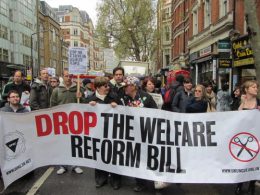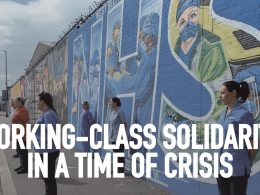A savage attack has been launched on working class people in Northern Ireland. The Comprehensive Spending Review announced by the Tory-Lib Dem Coalition government on 20 October represents around a 6.9% cut in public spending in the North over the next four years. This amounts to some £4 billion in revenue spending, and a 40% reduction in capital spending (on roads, hospitals and other public projects).
A report, published on 13 October by Pricewaterhouse-Cooper, estimated that 20,000 public sector jobs are under threat as a consequence of the Comprehensive Spending Review while a further 16,000 private sector jobs will be lost as a knock-on effect. A further £1 billion will be taken out of the Northern Ireland economy in benefit cuts and it has been estimated that this will result in a further 12,000 job losses. In total therefore 48,000 workers may join the 58,000 already on the dole queues.
Unemployment crisis
There are currently 779,000 people employed in the North (labour force statistics from the Department of Enterprise, Trade, and Investment). This means that at least 6% of all jobs are under imminent threat. Officially unemployment is currently running at 7% but could hit 12% or more over the next number of years – a rate not seen in more than 15 years. Working class areas will be devastated and a generation of youth will waste their best years on the dole.
The cuts in capital spending will ensure that the construction sector stays on the floor. The latest figures from the NI Construction Bulletin showed a 5.7% decrease in output during the past quarter, while total construction volume was 14.5% down over the same time period in 2009. It is estimated that at least 21,000 people have lost their jobs in the sector during the recession.
Chancellor George Osborne is cutting £81 billion in total over four and a half years. £18 billion will come from spending on benefits. The planned cuts in public spending and the rise in VAT due on January 1st 2011 will result in a loss of nearly 1.6 million jobs across the UK by 2015/16, according to the Chartered Institute of Personnel and Development (CIPD). It argued that an average of 320,000 private sector jobs a year would have to be created by 2015-16 just to keep unemployment steady at 2.5 million.
The full impact of the fiscal tightening announced by the government has been understated, according to the CIPD, including the forecast of 490,000 public sector job losses. According to its own estimates, the public sector will shed 725,000 jobs between 2009-10 and 2015-16. The private sector will be hit even harder, with 650,000 jobs going because of the direct and indirect impact of public spending cuts and an additional 200,000 because of the VAT rise.
Green shoots
The Government are making much of the third quarter figures for GDP (total output of goods and services) to back up its argument that the private sector will make up, and more, for job losses in the public sector. The economy grew in the July-September period by 0.8% (3.2% on an annual basis). This was a marked slowing from April-June, when GDP grew by 1.2% (4.8% on an annual basis). This growth has to be seen against Britain’s peak-to-trough fall in GDP over the recession of 6.4% (bigger than the US fall of 2.5%) and the fact that much of the growth of the last six months depended on New Labour’s stimulus package (public sector building projects, the vehicle replacement scheme, the temporary VAT cut, etc.) which is now played out.
It is estimated that Osborne’s package will cut real demand for goods and services by 8% of GDP and cut GDP by 4% over four years. Consumer spending is weak (it actually fell in September). Unemployment, part-time working, squeezed incomes, the debt-hangover from credit-fuelled spending, and fear of worse to come are dampening household spending. Many of the workers who hang on to their jobs will see their real incomes fall by 10-15% over the next few years as pay is frozen or cut but inflation remains high. In these circumstances economic growth will undoubtedly slow and a “double-dip” recession is entirely possible. What is to come is illustrated by the most recent economic news from the US, still the world’s biggest market, which slowed to a sluggish 0.5% growth in the third quarter (2% on an annualised basis).
Concern about a possible and imminent double-dip has led US policy-makers to announce further emergency measures to prop up the recovery. The Federal Reserve said on 3 November that it would pump an extra $600bn (£372.8 billion) into its economy over the next eight months in a second round of quantitative easing (effectively printing extra money). The Bank of England’s Monetary Policy Committee is expected to announce a similar move soon.
Assembly complicit
The Northern Ireland Assembly debated the CSR and unanimously voted for a motion condemning the cuts but agreed to work together and act “responsibly”. In other words, they have implicitly accepted the cuts. The focus now is on agreeing a budget for next year and on putting forward suggestions on where cuts could be made or revenue raised to offset them. A number of the parties have already come up with suggestions. DUP leader Peter Robinson called for a civil service pay freeze for the next two years for anyone earning more than £21,000. A wave of further privatisations is on the cards (including Belfast Harbour, MOT centres, NI Water and possibly the public transport network). SDLP leader Margaret Ritchie has called for a “social partnership” approach to public spending. The parties at Stormont are likely to agree to a budget that will hold off the biggest cuts as much as possible until after next year’s Assembly election.
The cuts mean misery for the vast majority of the population. The current Assembly parties all accept that the cuts “must” come. A new party for all working class and young people, which opposes all the cuts, must be built. The next Assembly election in May 2011 will provide a platform for the beginnings of a new political opposition in the North. The Socialist Party intends not just to campaign against the cuts in the months ahead but also to provide an alternative political voice where we can come next May.











